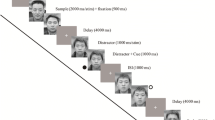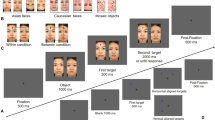Abstract
The present study investigated whether faces capture attention regardless of attentional set. The presentation of a face as a distractor during a visual search has been shown to impair performance relative to when the face was absent, implying that faces automatically attract attention. If attentional control is contingent on the observer’s current goal, faces should not capture attention when they are irrelevant to the observer’s attentional set. Previous studies demonstrating face-induced attentional capture used faces that were relevant to the task. Thus, a task in which faces were completely irrelevant to the observer’s set was created. Participants identified a target letter among heterogeneously colored non-targets while ignoring a peripheral facial image that appeared as a brief distractor. No face-specific capture was observed when the target-distractor stimulus onset asynchrony (SOA) was long (Experiment 1). When the SOA was shortened, attentional capture by irrelevant faces was observed (Experiment 2). Experiment 3 extended this finding to all conditions, regardless of the attractiveness of faces. No such capture effect was found in Experiment 4 with inverted-face distractors. These results indicate that completely task-irrelevant faces break through top-down attentional set given a brief distractor-target SOA.





Similar content being viewed by others
References
Ansorge, U., & Heumann, M. (2003). Top-down contingencies in peripheral cuing: the role of color and location. Journal of Experimental Psychology: Human Perception and Performance, 29, 937–948.
Bacon, W. F., & Egeth, H. E. (1994). Overriding stimulus-driven attentional capture. Perception and Psychophysics, 55, 485–496.
Bindemann, M., Burton, A. M., Hooge, I. T. C., Jenkins, R., & DeHaan, E. H. F. (2005). Faces retain attention. Psychonomic Bulletin & Review, 12, 1048–1053.
Bindemann, M., Burton, A. M., Langton, S. R. H., Schweinberger, S. R., & Doherty, M. J. (2007). The control of attention to faces. Journal of Vision, 7, 1–8.
Brainard, D. H. (1997). The Psychophysics Toolbox. Spatial Vision, 10, 433–436.
Cerf, M., Harel, J., Einhäuser, W., & Koch, C. (2008). Predicting human gaze using low-level saliency combined with face detection. Advances in Neural Information Processing (NIPS), 2007(20), 241–248.
Chen, P., & Mordkoff, J. T. (2007). Contingent capture at a very short SOA: evidence against rapid disengagement. Visual Cognition, 15, 637–646.
Christ, S. E., & Abrams, R. A. (2006). Abrupt onsets cannot be ignored. Psychonomic Bulletin & Review, 13, 875–880.
Eastwood, J. D., Smilek, D., & Merikle, P. M. (2001). Differential attentional guidance by unattended faces expressing positive and negative emotion. Perception & Psychologics, 63, 1004–1013.
Einhäuser, W., Rutishauser, U., & Koch, C. (2008). Task-demands can immediately reverse the effects of sensory-driven saliency in complex visual stimuli. Journal of Vision, 8, 1–19.
Folk, C. L., Leber, A. B., & Egeth, H. E. (2002). Made you blink! Contingent attentional capture produces a spatial blink. Perception and Psychophysics, 64, 741–753.
Folk, C. L., Leber, A. B., & Egeth, H. E. (2008). Top-down control settings and the attentional blink: evidence for non-spatial contingent capture. Visual Cognition, 16, 616–642.
Folk, C. L., & Remington, R. (1998). Selectivity in distraction by irrelevant featural singletons: evidence for two forms of attentional capture. Journal of Experimental Psychology: Human Perception and Performance, 24, 847–858.
Folk, C. L., Remington, R. W., & Johnston, J. C. (1992). Involuntary covert orienting is contingent on attentional control settings. Journal of Experimental Psychology: Human Perception and Performance, 18, 1030–1044.
Forster, S., & Lavie, N. (2008). Failures to ignore entirely irrelevant distractors: the role of load. Journal of Experimental Psychology: Applied, 14, 73–83.
Franconeri, S. L., Hollingworth, A., & Simons, D. J. (2005). Do new objects capture attention? Psychological Science, 16, 275–281.
Ghorashi, S. M. S., Zuvic, S. M., Visser, T. A. W., & Di Lollo, V. (2003). Focal distraction: spatial shifts of attentional focus are not required for contingent capture. Journal of Experimental Psychology: Human Perception and Performance, 29, 78–91.
Halit, H., Csibra, G., Volein, Á., & Johnson, M. H. (2004). Face-sensitive cortical processing in early infancy. Journal of Child Psychology and Psychiatry, 45, 1228–1234.
Inukai, T., Kawahara, J.-I., & Kumada, T. (2010). Nonspatial interdimensional attentional capture. Attention, Perception, & Psychophysics, 72, 658–666.
Jenkins, R., Lavie, N., & Driver, J. (2003). Ignoring famous faces: category specific dilution of distractor interference. Perception and Psychophysics, 65, 298–309.
Jonides, J., & Yantis, S. (1988). Uniqueness of abrupt visual onset in capturing attention. Perception and Psychophysics, 43, 346–354.
Kahneman, D., Treisman, A., & Burkell, J. (1983). The cost of visual filtering. Journal of Experimental Psychology: Human Perception and Performance, 9, 510–522.
Kawahara, J., Yanase, K., & Kitazaki, M. (2012). Attentional capture by the onset and offset of motion signals outside the spatial focus of attention. Journal of Vision, 12, 1–13.
Kirchner, H., & Thorpe, S. (2006). Ultra-rapid object detection with saccadic eye movements: visual processing speed revisited. Vision Research, 46, 1762–1776.
Langton, S. R. H., Law, A. S., Burton, A. M., & Schweinberger, S. R. (2008). Attention capture by faces. Cognition, 107, 330–342.
Lavie, N., Ro, T., & Russell, C. (2003). The role of perceptual load in processing distractor faces. Psychological Science, 14, 510–515.
Leber, A. B., & Egeth, H. E. (2006). It’s under control: top-down search strategies can override attentional capture. Psychonomic Bulletin & Review, 13, 132–138.
Lien, M.-C., Ruthruff, E., Goodin, Z., & Remington, R. W. (2008). Contingent attentional capture by top-down control settings: converging evidence from event-related potentials. Journal of Experimental Psychology: Human Perception and Performance, 34, 509–530.
Li, F. F., VanRullen, R., Koch, C., & Perona, P. (2002). Rapid natural scene categorization in the near absence of attention. Proceeding of the National Academy of Sciences, 99, 9596–9601.
Maner, J. K., Gailliot, M. T., & DeWall, C. N. (2007). Adaptive attentional attunement: evidence for mating-related perceptual bias. Evolution and Human Behavior, 28, 28–36.
Pelli, D. G. (1997). The VideoToolbox software for visual psychophysics: transforming numbers into movies. Spatial Vision, 10, 437–442.
Pratt, J., & McAuliffe, J. (2002). Determining whether attentional control settings are inclusive or exclusive. Perception and Psychophysics, 64, 1361–1370.
Ro, T., Russell, C., & Lavie, N. (2001). Changing faces: a detection advantage in the flicker paradigm. Psychological Science, 12, 94–99.
Rousselet, G. A., Macé, M. J.-M., & Fabre-Thorpe, M. (2003). Is it an animal? Is it a human face? Face processing in upright and inverted natural scenes. Journal of Vision, 3, 440–455.
Schreij, D., Owens, C., & Theeuwes, J. (2008). Abrupt onsets capture attention independent of top-down control settings. Perception and Psychophysics, 70, 208–218.
Shapiro, K. L., Arnell, K. M., & Raymond, J. E. (1997). The attentional blink. Trends in Cognitive Science, 1, 291–296.
Theeuwes, J. (2010). Top-down and bottom-up control of visual selection. Acta Psychologica, 135, 77–99.
Theeuwes, J., & Van der Stigchel, S. (2006). Faces capture attention: evidence from inhibition of return. Visual Cognition, 13, 657–665.
Thorpe, S., Fize, D., & Marlot, C. (1996). Speed of processing in the human visual system. Nature, 381, 520–522.
Van der Stigchel, S., Belopolsky, A. V., Peters, J. C., Wijnen, J. G., Meeter, M., & Theeuwes, J. (2009). The limits of top-down control of visual attention. Acta Psychologica, 132, 201–212.
von Mühlenen, A., & Lleras, A. (2007). No-onset looming motion guides spatial attention. Journal of Experimental Psychology: Human Perception and Performance, 33, 1297–1310.
Wyble, B., Folk, C., & Potter, M. C. (2013). Contingent attentional capture by conceptually relevant images. Journal of Experimental Psychology: Human Perception and Performance, 39, 861–871.
Yin, R. K. (1969). Looking at upside-down faces. Journal of Experimental Psychology, 81, 141–145.
Acknowledgments
This study was supported by Grant-in-Aid for Scientific Research on Innovative Areas, “Face perception and recognition” from MEXT KAKENHI 23119731 to JK. We thank Shoko Kanaya for her helpful comments on this work.
Author information
Authors and Affiliations
Corresponding author
Rights and permissions
About this article
Cite this article
Sato, S., Kawahara, J.I. Attentional capture by completely task-irrelevant faces. Psychological Research 79, 523–533 (2015). https://doi.org/10.1007/s00426-014-0599-8
Received:
Accepted:
Published:
Issue Date:
DOI: https://doi.org/10.1007/s00426-014-0599-8




